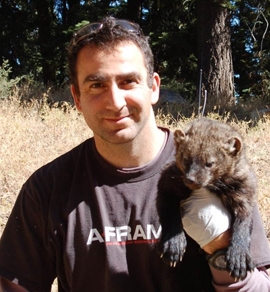Poisons on public lands put wildlife at risk
Rat poison used on illegal marijuana farms may be sickening and killing the fisher, a rare forest carnivore that makes its home in some of the most remote areas of California, according to a team of researchers led by University of California, Davis, veterinary scientists.
Researchers discovered commercial rodenticide in dead fishers in Humboldt County near Redwood National Park and in the southern Sierra Nevada in and around Yosemite National Park. The study, published July 13 in the journal PLoS ONE, says illegal marijuana farms are a likely source. Some marijuana growers apply the poisons to deter a wide range of animals from encroaching on their crops.
Fishers in California, Oregon and Washington have been declared a candidate species for listing under the federal Endangered Species Act. Fishers, a member of the weasel family, likely become exposed to the rat poison when eating animals that have ingested it. The fishers also may consume rodenticides directly, drawn by the bacon, cheese and peanut butter “flavorizers” that manufacturers add to the poisons.
Other species, including martens, spotted owls, and Sierra Nevada red foxes, may be at risk from the poison, as well.
“Our findings were very surprising since non-target poisoning from these chemicals is typically seen in wildlife in urban or agricultural settings,” said lead author Mourad Gabriel, a UC Davis Veterinary Genetics Laboratory researcher and presid
ent of the Integral Ecology Research Center. “In California, fishers inhabit mature forests within the national forest, national parks, private industrial and tribal community lands – nowhere near urban or agricultural areas.”“I am really shocked by the number of fishers that have been exposed to significant levels of . . . anticoagulant rodenticides,” said pathologist Leslie Woods of the UC Davis California Animal Health and Food Safety Laboratory System.
Exposure to the poison was high throughout the fisher populations studied, complicating efforts to pinpoint direct sources. The fishers, many of which had been radio-tracked throughout their lives, did not wander into urban or agricultural environments. However, their habitat did overlap with illegal marijuana farms.
Gabriel said fishers may be an “umbrella” species for other forest carnivores. In ecology, an umbrella species is one that, if protected, results in protection of ot
her species, as well.“If fishers are at risk, these other species are most likely at risk because they share the same prey and the same habitat,” said Gabriel. “Our next steps are to examine whether toxicants used at illegal marijuana grow sites on public lands are also indirectly impacting fisher populations and other forest carnivores through prey depletion.”
In addition to UC Davis, the study involved researchers from the nonprofit Integral Ecology Research Center, UC Berkeley, United States Forest Service, Wildlife Conservation Society, Hoopa Tribal Forestry, and California Department of Fish and Game.
(This article was condensed from a UC Davis news release. Read the full press release and watch a flash video of fishers in the wild.)



